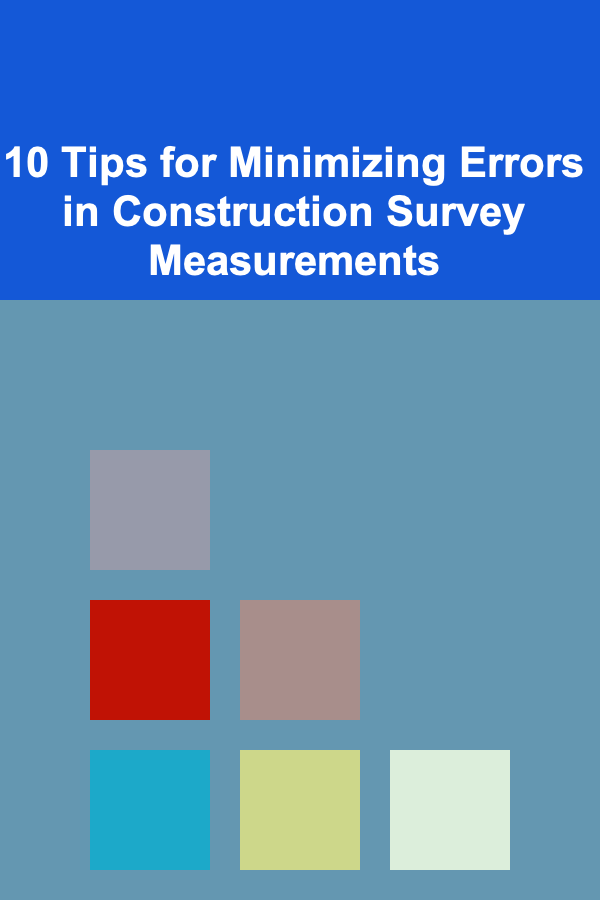
10 Tips for Minimizing Errors in Construction Survey Measurements
ebook include PDF & Audio bundle (Micro Guide)
$12.99$11.99
Limited Time Offer! Order within the next:

Surveying is an essential part of the construction process, helping ensure that structures are built accurately and safely. Errors in construction survey measurements can lead to costly mistakes, delays, and even safety hazards. It's vital for professionals in the field to minimize these errors through precision, careful planning, and the correct use of equipment. This article outlines 10 practical tips that can help minimize errors in construction survey measurements, enhancing the quality of your projects and avoiding potential pitfalls.
Ensure Proper Equipment Calibration
One of the most common sources of error in construction surveys is the miscalibration of measurement instruments. Whether you're using a total station, GPS system, or traditional tools like a level and tape measure, it's essential to regularly calibrate your equipment before use. Calibration ensures that the instruments provide accurate readings and reduce the likelihood of errors due to faulty measurements.
For instance, total stations and GPS systems can sometimes drift over time, and a simple calibration check can save you from significant mistakes in measurement. Furthermore, manual measuring tools like theodolites and levels should be calibrated periodically to ensure their accuracy. This step is especially crucial for high-precision measurements in projects like high-rise buildings or complex infrastructure.
Tip:
- Always calibrate your equipment before each survey session and keep a log of calibration checks to track any potential issues with your instruments.
Double-Check Survey Points and Benchmarks
Survey points and benchmarks serve as the foundation for most measurements in construction surveying. If these reference points are incorrectly placed or disturbed, it can lead to inaccurate measurements throughout the entire project. Before starting, make sure that your survey points and benchmarks are correctly established and remain undisturbed.
It's also important to revisit these points throughout the project. If a construction project involves earthmoving, digging, or foundation work, survey points can easily be altered or damaged. Double-checking the stability and accuracy of your benchmarks will prevent future measurement discrepancies.
Tip:
- Mark survey points and benchmarks with durable, permanent markers or physical structures to prevent them from being disturbed during construction activities.
Account for Instrument Setup and Alignment
Incorrect instrument setup is a frequent cause of errors in construction survey measurements. The total station, level, or other surveying instruments need to be properly aligned with the designated reference points. Misalignment can lead to measurement inaccuracies that will propagate throughout the survey process. Ensuring the instrument is level and properly aligned is critical.
Additionally, the height of the instrument should be consistent throughout the survey. If it's moved or adjusted frequently, it's essential to recalibrate or recheck the measurements at each setup.
Tip:
- Always use a tripod or stable surface for your surveying equipment, and verify that the instrument is level and aligned with the correct reference points before taking measurements.
Avoid Environmental Interference
Environmental factors such as temperature, humidity, wind, and even lighting can have an impact on the accuracy of construction survey measurements. For example, temperature fluctuations can cause the materials used for measuring (like steel tape measures) to expand or contract, which can lead to errors. Wind can affect the stability of the surveying instrument, especially during long-distance measurements.
Whenever possible, perform measurements under stable environmental conditions. If you must survey in adverse conditions, take precautions to minimize their effects. Use temperature-compensated measuring instruments and secure your equipment to prevent movement caused by wind.
Tip:
- Take measurements during times of the day when environmental conditions are more stable, or use weatherproof equipment that can tolerate outdoor conditions.
Use Redundant Measurements for Accuracy
To minimize the risk of errors, always take multiple measurements of the same point. This is particularly important for key measurements that will affect the entire layout of the project. By taking redundant measurements and averaging the results, you can ensure greater accuracy and detect any inconsistencies early.
If the measurements significantly differ, it's essential to investigate the cause of the discrepancy before continuing with the project. This step not only ensures that the measurements are correct but also helps in identifying equipment malfunctions or human errors.
Tip:
- For critical measurements, take at least three independent measurements of each point and calculate the average value for higher accuracy.
Maintain Consistent Measurement Techniques
The method used to take measurements can influence their accuracy. Whether you're using a laser, tape measure, or total station, consistency is key. If multiple surveyors are involved in the process, make sure they follow the same technique and methodology for measurements to avoid discrepancies.
In addition to consistency in technique, it's essential to understand the limitations of your tools. For example, while a laser distance meter may be accurate for certain distances, it might not be as effective for measuring long distances or in areas with obstructions.
Tip:
- Standardize measurement techniques across the entire team and ensure everyone is familiar with the capabilities and limitations of the equipment they are using.
Consider the Scale of the Project
The scale of the project can significantly impact the precision required in your measurements. For example, small-scale projects, such as residential homes, might tolerate minor discrepancies without significant consequences. However, large-scale projects like bridges or high-rise buildings demand high-precision measurements, and even small errors can result in large problems.
For large-scale projects, it's crucial to use the most precise equipment available and involve experienced surveyors who can detect and correct errors before they become major issues. The larger the project, the more important it is to minimize any errors from the beginning.
Tip:
- Tailor your surveying methods to the scale of the project, and use high-precision instruments for large-scale projects.
Cross-Check Measurements with Other Surveying Methods
Cross-checking your measurements using different methods can help identify any errors early. For instance, if you are measuring distances using a total station, you can cross-check by using a tape measure or laser distance meter for the same points. Additionally, if possible, compare your measurements with existing plans or data from previous surveys.
By utilizing different surveying techniques, you can confirm the consistency of your measurements and spot potential discrepancies.
Tip:
- Use multiple surveying methods (e.g., total stations, GPS, and laser measurements) to cross-check and validate your data.
Train Surveyors Regularly
Human error is an inevitable part of any profession, but the frequency of mistakes can be minimized with proper training and experience. Surveyors should regularly undergo training to stay updated on the latest technologies, measurement techniques, and best practices in the field. Additionally, they should understand the implications of measurement errors and be well-versed in methods to correct them.
Training should include practical experience with equipment calibration, setup, measurement techniques, and data analysis. As surveying technologies evolve, staying updated with new tools and methods will help improve the quality of work and reduce the risk of errors.
Tip:
- Provide ongoing training for surveyors to ensure they're proficient in using modern surveying equipment and can identify and minimize potential errors.
Implement Proper Data Management and Record-Keeping
Errors in measurements can also result from poor data management. Properly recording all measurements, instrument settings, calibration results, and environmental conditions is essential for ensuring that your measurements are accurate and traceable. Good data management allows for quick retrieval of information and provides a historical record that can be referenced if discrepancies arise later in the project.
Make use of digital tools for data recording and management. Many modern surveying instruments come with software that can automatically record and process measurements, reducing the likelihood of human error.
Tip:
- Implement a digital data management system to record and store survey measurements, making it easier to track changes, identify errors, and retrieve past records.
Conclusion
Minimizing errors in construction survey measurements is critical for the success of any construction project. By ensuring proper calibration of equipment, carefully selecting survey points, accounting for environmental factors, and implementing consistent measurement techniques, you can reduce the likelihood of inaccuracies. Additionally, regular training, redundant measurements, and effective data management are essential for maintaining high standards of precision in construction surveying.
With these 10 tips in mind, construction professionals can significantly enhance the accuracy of their survey measurements, ensuring that projects are completed safely, on time, and within budget.
Reading More From Our Other Websites
- [Organization Tip 101] How to Organize Shoes to Keep Your Entryway Neat
- [Organization Tip 101] How to Organize Group Music Activities in Your Space
- [Soap Making Tip 101] DIY Sustainable Soap: Using Upcycled Kitchen Oils to Reduce Waste
- [Home Budget 101] How to Create a Simple Home Budget That Works for You
- [Organization Tip 101] How to Make Budgeting a Fun Family Activity
- [Home Storage Solution 101] How to Optimize Bathroom Storage for a Clutter-Free Space
- [Home Renovating 101] How to Choose the Best Kitchen Cabinets for Your Renovation
- [Stamp Making Tip 101] Best Guide to Stamp‑Making Techniques for Collectors
- [Tiny Home Living Tip 101] Best Insulation Techniques for Tiny Homes in Extreme Cold Zones
- [Home Party Planning 101] How to Plan a Home Party with Outdoor Games and Activities

How to Leverage Home Staging to Increase Property Value
Read More
How to Prepare for Remote Island Living
Read More
How to Use a Budget App to Track Spending Effectively
Read More
Mastering Legal Secretary Tasks: A Practical Guide
Read More
How To Protect Your Brain from Age-Related Decline
Read More
How to Budget for Travel on a Tight Budget
Read MoreOther Products

How to Leverage Home Staging to Increase Property Value
Read More
How to Prepare for Remote Island Living
Read More
How to Use a Budget App to Track Spending Effectively
Read More
Mastering Legal Secretary Tasks: A Practical Guide
Read More
How To Protect Your Brain from Age-Related Decline
Read More